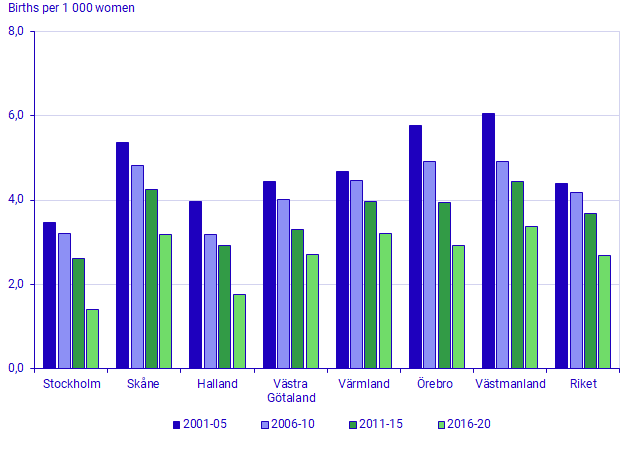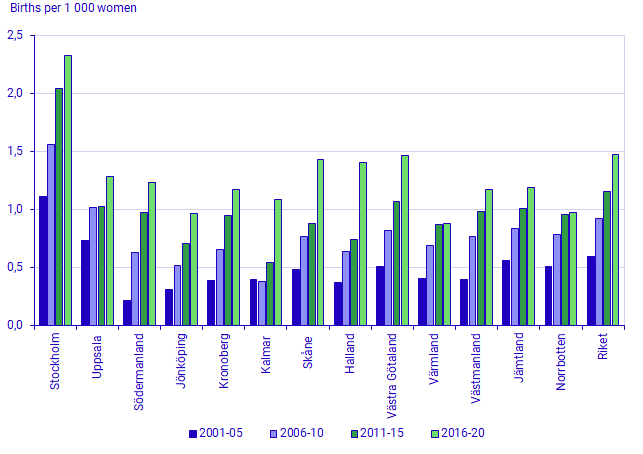Demographic Analysis (DEMOG) Childbearing among women aged 15–19 and 45–49 years
Older mothers: more frequent but not common
Statistical news from Statistics Sweden 2021-12-06 9.30
Since 1970, the number of births among women aged 15–19 years has dropped sharply from just over 7 000 births to roughly 500 births per year, while the number of births among women aged 45–49 years has increased from around 120 to 500 births per year. Today, the number of births is roughly the same among younger and older women. Childbirth in these two age groups account for roughly 1 percent of total childbirth in Sweden.
A report published by Statistics Sweden describes childbearing among women aged 15–19 years and 45–49 years. The report presents changes at the county level in the period 2001—2020 and how childbearing has varied by national background, educational attainment and family situation.
Childbearing among younger women declined in all counties
Compared with the period 2001—2005, fertility among younger women is considerably lower in all counties in the last five-year period, 2016—2020. One in three counties have had a steady and continuous decline since the period 2001—2005. In the remaining counties, the decline was not as clear in the early 2000s.

In the last 15-year period, the highest fertility rates among younger women were noted in counties such as Gävleborg and Östergötland. The counties with the lowest fertility rates included Stockholm, Uppsala, and Halland.
Younger women with a foreign background have higher fertility rates than those with a Swedish background. During the study period, fertility declined among those with Swedish background as well as those with a foreign background.
Childbearing among older women increased in most counties
In 13 counties, fertility rates have increased continuously since the period 2001—2005. In the remaining counties, fertility rates have developed in various ways over the study period.

Throughout the study period, the highest fertility rate among older women was noted in Stockholm. Stockholm County accounted for nearly 40 percent of childbirths among older women in the last five-year period.
Childbearing among older singles increased in recent years
Older women with a foreign background have a higher fertility rate than those with a Swedish background. In the study period, the development has been similar in both groups.
During most of the 2000s, older women with the highest educational attainment, post-secondary education three years or longer, have had the highest fertility rates. In the period 2016—2020, fertility rates were somewhat higher among women with the lowest level of educational attainment, compulsory education, than among those with the highest level of educational attainment.
In the period 2012–2015, fertility rates among single women and women in cohabitation or marriage aged 45–49 years were roughly on a par. In the subsequent years, the fertility rate among single persons increased somewhat faster and in recent years, has been somewhat higher than among those in cohabitation or marriage.
Definitions and explanations
Fertility rate is defined as the number of children born to women of a certain age divided by the average population of women at that age.
Information on the number of women and births in the population was collected from the Total Population Register (RTB). Information on educational attainment among women was collected from the Register on educational attainment of the population (UREG).
In the report, the family situation of women the previous year is used to calculate fertility in a given year. Information about the family situation is collected from the RTB and is based on data from the population registration. Women who are not registered together with their partner or who move in with a partner the same year they have children are considered as single persons in the statistics.
Publication
Demographic report: Childbearing among women aged 15–19 and 45–49 years
Feel free to use the facts from this statistical news but remember to state Source: Statistics Sweden.
